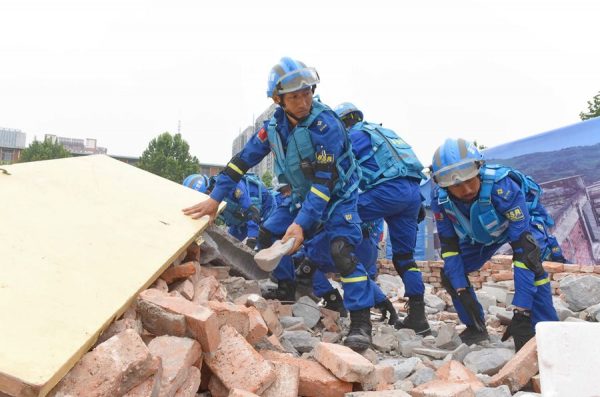
The deadly event forced the country to improve the emergency rescue system, as Hou Liqiang reports from Beijing with Liu Kun in Wuhan.
The 2008 Wenchuan earthquake, one of the deadliest natural disasters in China’s history, marked a watershed in the country’s approach to emergency relief. In the 10 years since the temblor, which claimed more than 69,000 lives and left nearly 18,000 people missing, there has been a 200-fold rise in the number of State-backed and volunteer rescue groups. Meanwhile, the equipment used to find survivors and save lives has become increasingly sophisticated.
Many of those who took part in the Wenchuan relief effort spoke later of the heartbreak of seeing trapped people dying but being unable to help because of a lack of equipment allied to poor rescue skills. The experience was the start of China’s efforts to upgrade the country’s disaster response capabilities, especially in the establishment of volunteer rescue teams.
While even 10 years ago rescue work was mainly conducted with shovels and ropes, today it is common to see volunteer teams using unmanned aerial vehicles, or drones, and thermal-imaging equipment to pinpoint the location of survivors trapped in rubble.
When the Blue Sky Rescue Team, the country’s first registered nonprofit volunteer outfit, took part in the Wenchuan relief operation, its members were untrained outdoors enthusiasts. Team leader Zhang Yong described the outfit as a scratch team with huge enthusiasm but limited experience and almost no equipment.
Recalling the rescue a decade later, he said the words that sprung to mind were “sad” and “powerless” because, lacking equipment and skills, the team could only help to transport relief materials.
“Often we knew someone was buried in the rubble nearby, but we were powerless to help,” he said, recalling a man who was pinned down in a gap between fallen rocks. Zhang and his team were able to pass a rope to the man, who tied it around his waist. However, he was wedged so hard that it was impossible to pull him free. Despite 10 hours of efforts to rescue him, the man died. To make matters worse, his mother and brother were at the scene, constantly appealing to Zhang and his team for help.
While the members of the team were badly affected by their “failure”, the incident made them determined to develop their skills. In the years that followed, Zhang and his fellow leaders organized regular training sessions that focused on a variety of rescue techniques and the use of professional equipment. The voluntary organization now has about 30,000 members who form 419 teams across the country.
“If a disaster strikes within China, one of our teams can be at the scene in about four hours,” Zhang said.
In addition to domestic operations, the team has taken part in at least eight relief missions overseas, including the Nepal earthquake in April 2015. The first batch of Blue Sky members arrived at the affected area just one day after the quake, fully trained to deal with a variety of tasks.
Using thermal-imaging apparatus and state-of-the-art lifting and securing equipment, the team, including Blue Sky experts, spent 15 days in Nepal searching for survivors, restoring water supplies and providing medical services to more than 2,000 people.
“More than 70 international rescue teams participated in the Nepal earthquake operation and found 178 bodies. Our 84-member team found 24 of them,” Zhang said.

Newcomers
Since 2008, the handful of rescue teams in existence before Wenchuan, such as Blue Sky, have been joined by a raft of newcomers, all dedicated to providing assistance in the face of adversity.
According to the recently established Ministry of Emergency Management, before Wenchuan there were 27 State-backed earthquake rescue teams in China – one national team and 26 provincial outfits – that employed 4,200 people.
However, as of March, the number of employees had rocketed to more than 250,000, and the earthquake rescue system had evolved into a four-tier organization reaching down to the county level. At the same time, there were 11,000 volunteer rescue teams with 694,000 members.
Xiang Dong from Wuhan, capital of Hubei province, founded a volunteer rescue team in 2009 after friends told him how frustrated they had been during the Wenchuan relief operation.
Xiang named the team “Clouded Leopard”, after the big cat renowned for its climbing abilities.
Xiang’s team, which has more than 300 members, is equipped with 16 drones – including ones that can detect poisonous gases, and others designed specifically for rescue operations on water or in high-rise buildings – a command vehicle and thermal-imaging equipment.
“Our high-tech devices can guarantee to search an area of more than 100 square kilometers, and can provide an effective means of finding survivors, missing people and escape routes in dark, densely smoky and foggy environments in forests and ravines,” he said.
When he traveled to Nepal to assist with relief efforts after the 2015 earthquake, Xiang led a team of three that pulled two seriously injured people from the rubble during their four days in the country.
He said members of India’s official rescue team were astonished to discover that a voluntary team from China had access to thermal-imaging equipment when they worked together to search a collapsed building. “Only one or two in every 20 teams were equipped with that sort of equipment,” he added.
The demands on those who want to join the team are high. In addition to being in excellent physical condition, members must be fluent in English. “We conduct rescues with high-tech devices, many of which we have imported from overseas. The members need to know English to read the instruction manuals,” Xiang said.
Growing recognition
In keeping with its long history, the Blue Sky Rescue Team has been making efforts to win international recognition and support. In May, Zhang invited two senior Swiss experts from the International Search and Rescue Advisory Group, or Insarag, a network of more than 80 countries and organizations that operates under the United Nations umbrella, to spend three days evaluating the team and giving lectures.
The team is working to ensure it will pass the Insarag External Classification appraisal procedure. If successful, Blue Sky will become the 52nd team in the world to pass the appraisal and only the second in China, after the Chinese International Search and Rescue Team, the national earthquake rescue team.
“China is a strong country. Our volunteers have gained deep rescue experience and have the ability to go beyond China to shoulder the country’s international responsibilities, so we are making the effort to learn and improve,” Zhang said.


